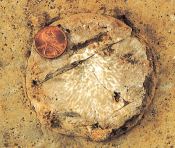Sponges
Phylum Porifera

Actinocoelia maeandrina
The sponge is so simple! Just a loose colony of cooperating single cells, some for catching food with their tiny hair-like cilia. Other cells wander amoeba-like through the colony to distribute food, and some cells engineer skeletal supports. These may be made of little needles or stars of silica called spicules. Altered masses of spicules make the white color in the photo.
This sponge's skeleton is silica. When the sponge dies, the silica spicules partially dissolve. When the dissolved silica precipitates to the sea floor, it becomes durable chert, also called flint. As a result, the sponge is responsible for filling the Kaibab Formation with hard and durable chert. For this reason, erosion has lowered the Grand Canyon's landscape only as far as the Kaibab Formation and no farther. In a sense, the lowly sponge, the softest of creatures, is the reason we have a Grand Canyon instead of a broad valley.